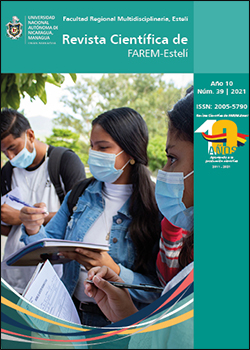Experience in the selection process of students to calculate hematological reference values in a public university in Nicaragua
DOI:
https://doi.org/10.5377/farem.v10i39.12618Keywords:
Criteria; exclusion, inclusion, norm EP-28-A3c, studentsAbstract
The selection of research subjects is determined by 3 factors, the first related to the researcher’s criteria according to the objectives, the second established by the inclusion criteria that define exactly who enters the study and the third by exclusion criteria that define why some subjects do not meet the mandatory requirements. The objective was to describe the experience in order to obtain a reference sample according to inclusion and exclusion criteria, taking as a model some aspects suggested by the EP 28-A3c standard while maintaining the rigorousness criteria of the research. This was a descriptive, cross-sectional study conducted at the Rubén Darío Campus (RURD) of the National Autonomous University of Nicaragua, Managua UNAN-Managua Nicaragua. Two phases were carried out: The first consisted of an open convocation and the second consisted of a clinical evaluation plus blood screening. The health survey was designed based on the EP 28-A3c standard. The health survey and blood screening was the instrument used to select the students to obtain the sample. The main results were: of 901 (100%) students who responded to the invitation, 607 (67.4%) met the selection criteria, distributed by sex: 340 (56%) females and 267 (44%) males. The 196 (32.3%) students were excluded at the clinical evaluation stage for presenting current medication 17.6%, recent consultation 12.03%, gynecological problems 10.48%, anemia 6.43%, abnormal blood pressure 5.72%, obesity 4.6%, consume of alcohol, tobacco or drugs 1.19% among others. An objective and successful result was obtained to obtain the sample selection through the application of standard EP 28-A3c, which allowed establishing selection criteria that guarantee the minimum of biological bias, increasing the validity and confidence of the study.
Downloads
References
Astete , N., Alian, A., & Fuentes, R. (2019). Estudiantes de la salud como sujetos de estudio en investigación. International Journal of Morphology, pp 149-158 / http://dx.doi.org/10.4067/S0717-95022019000100149.
Ávila Baray, H. (2006). Introducción a la metodologia de la investigación . Edición electrónica. Cuauhtémoc (Chihuahua), Instituto Tecnológico de Cd. Cuauhtémoc., https://www.eumed.net/libros-gratis/2006c/203/.
Chouaid , C., Dujon , C., Do P, M., & Madroszyk , A. (2014). Feasibility and clinical impact of re-biopsy in advanced non small-cell lung cancer: a prospective multicenter study in a real-world setting. doi: 10.1016/j.lungcan.2014.08.016. Epub 2014 Aug 29. PMID: 25214431.: Nov;86(2).
Clinical and Laboratory Standard Institute, C. (2016).
CLSI. (2010). Defining, establishing and verifyng reference intervals in the. Obtenido de https:www.clsi.org
Garg, R. (2016). Methodology for research I. Indian Journal of anaesthesia , pp 640- 645.
Gérvas, J., & Pérez Andrés, C. (2008). EVALUACIÓN DE LAS INTERVENCIONES EN SALUD LA BÚSQUEDA DEL EQUILIBRIO ENTRE LA VALIDEZ INTERNA DE LOS RESULTADOS Y LA VALIDEZ EXTERNA DE LAS CONCLUSIONES. Rev Española Salud Pública, 577-579.
Instituto de estandarización de laboratorio clinico (CLSI), F. I. (2016). CLSI, IFCC,NORMA EP 28- A3c. Obtenido de https://clsi.org/
Keung, E. Z., McElroy, L., Ladner, D., & Grubb, E. (2020). Defining the Study Cohort: Inclusion and Exclusion Criteria. Clinical Trials, pp 47-58.
Manzano Nunez , R., & Garcia Perdomo, H. A. (2016). Sobre los criterios de inclusión y exclusión. Más allá de la publicación. Revista Chilena de Pediatría , pp 511-512.
Martínez Arias, M., López Martínez, B., & Parra-Ortega, I. (2014). Determinación de intervalos de referencia para las pruebas básicas de coagulación en población mexicana. Revista Latinoamaericana de Patologia Clinica , pp 138-139.
Masayuki Ochiai, Y. M., Hirosuke Inoue, T. K., & Dongchon Kang, K. I. (2016). Blood Reference Intervals for Preterm LowBirth-Weight Infants: A Multicenter Cohort. PLOS ONE, pp 1-11 / DOI:10.1371/journal.pone.0161439.
Morales Godoy, A. (2014). Determinación de Valores de Referencia Hematologicos en Dadores Voluntarios de Sangre de la Región Metropolitana de Chile. Santiago Chile: UNIVERSIDAD FACULTAD DE MEDICINA ESCUELA DE SALUD PÙBLICA.
Otzen, T., & Manterola, C. (2017). Técnicas de Muestreo sobre una Población a Estudio. Int. J. Morphol, 35(1):227-232.
Parametros orientados por la norma A3c, E. (2010). Defining, Establishing, and Verifying Reference Intervals in the Clinical Laboratory, Approved Guideline. CLSI.
Parreño Urquizo, Á. (2016). Metodología de investigación en salud. Riobamba: Escuela Superior Politécnica de Chimborazo.Instituto de Investigaciones: 124 p. vol: 17 x 24 cm.
Patino, C. M., & Carvalho Ferreira, J. (2018). Inclusion and exclusion criteria in research studies: definitions and why they matter. Journal Brasileiro de Pneumologia , pp 84. /https://www.scielo.br/j/jbpneu/a/LV6rLNpPZsVFZ7mBqnzjkXD/?lang=en.
PEÑA TUMAY, A. E. (2018). “Validación para la transferencia de los intervalos de referencia de la citometría hemática establecidos por la OMS a la población de hombres y mujeres de entre 20 a 40 años, atendidos en un laboratorio privado, siguiendo el protocolo de la guía EP28-A3C. LIMA-PERU: TESIS PARA OPTAR EL TÍTULO PROFESIONAL DE LICENCIADO EN TECNOLOGÍA MÉDICA EN LABORATORIO CLÍNICO Y ANATOMÍA PATOLÓGIA.
Polit, D. F., & Beck, C. T. (2010). Essentials of Nursing Research: Appraising Evidence for Nursing Practice. 7th Edition: Wolters Kluwer Health/Lippincott Williams & Wilkins, Philadelphia.
Salinas Meruane, P., & Cárdenas Castro, M. (2009). Métodos de investigación social. Quito - Ecuador: Segunda Edición . Ediciones Universidad Católica del Norte .
Sampieri, R., Fernández, C. & Baptista, P. (2010). METODOLOGÍA DE LA INVESTIGACIÓN. McGrawHill.
SEQC, S. E. (1993). Documento rector de Comité de Valores de Referencia de la sociedad escandinava de Química Clínica Scand,. J Clin Land Invest.
Solberg H, E. (2004). “The IFCC recommendation on estimation of reference intervals. The RefVal Program. Clinical Chemistry and Laboratory Medicine (CCLM), vol. 42, no. 7, pp. 710-714 / doi.org/10.1515/CCLM.2004.121.
Triola, M. F. (2009). Estadística. México: PEARSON EDUCACIÓN/ DECIMA EDICIÓN.
Valle S, W. (2012). Validez interna y externa . Metodologia de la Investigación. Escuela profesional de psicologia: Universidad Católica los Ángeles de Chimbote.
Published
Issue
Section
License
Copyright (c) 2021 Revista Científica de FAREM-Esteli

This work is licensed under a Creative Commons Attribution-NonCommercial-ShareAlike 4.0 International License.



